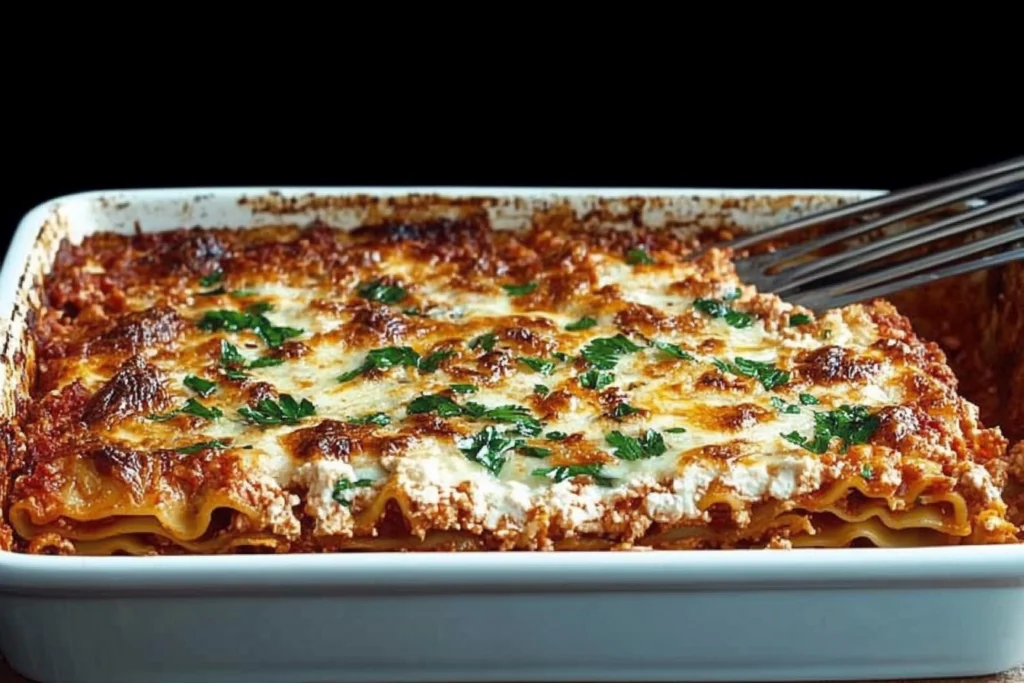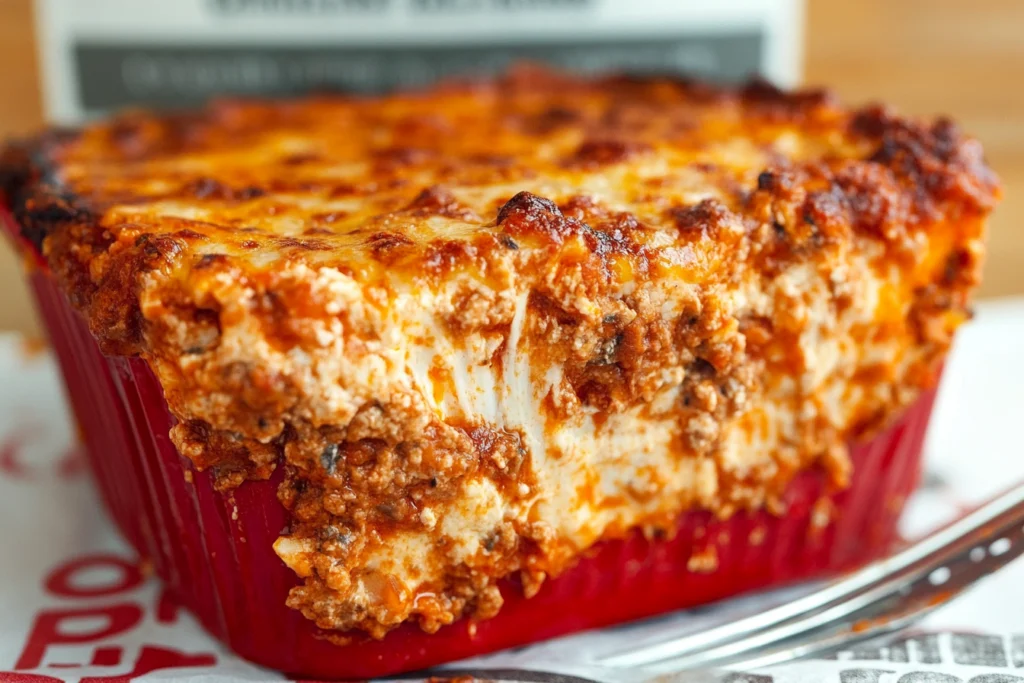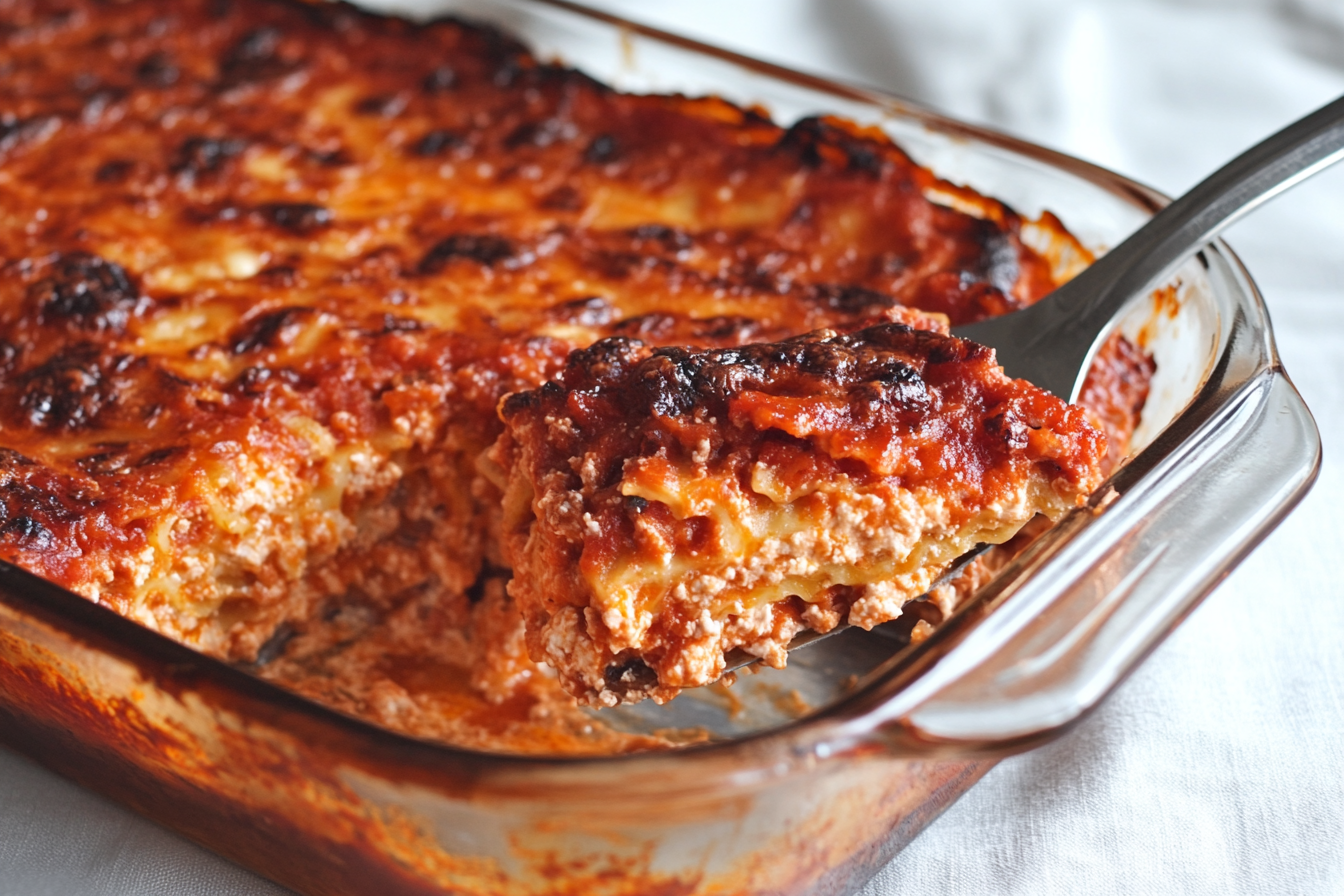Part 1: Introduction and Preparation
What is Oven-Ready Lasagna?
Oven-ready lasagna sheets are pre-cooked pasta sheets designed to save time in the kitchen. Unlike traditional lasagna sheets, which require boiling, these are ready to use straight out of the package. As they bake, they absorb moisture from the sauce and other ingredients, creating a perfect texture and flavor.
One of the key differences between oven-ready and traditional sheets is their convenience. While traditional sheets can be messy and time-consuming, oven-ready lasagna sheets streamline the process, making lasagna an easy dish to prepare—even on busy weeknights.
Why Choose Oven-Ready Lasagna?
- Convenience and Time-Saving Benefits
- First, they eliminate the need for boiling and draining pasta sheets, which significantly reduces preparation time.
- Furthermore, since there’s no extra pot to clean, you can save time on cleanup too.
- Retains Authentic Flavor and Texture
- Properly layered, oven-ready lasagna mimics the rich, traditional flavor that lasagna enthusiasts adore.
- Additionally, the sheets soak up the sauce beautifully, ensuring every bite is flavorful.
With these benefits in mind, it’s no wonder oven-ready lasagna has become a staple for both novice cooks and seasoned chefs.
Essential Ingredients for Oven-Ready Lasagna
To create a delicious oven-ready lasagna, you’ll need the following:
- Pasta Sheets: Choose high-quality, oven-ready lasagna sheets for the best results.
- Sauces: Tomato-based, béchamel, or specialty sauces are all excellent choices.
- Cheeses: Mozzarella, ricotta, and parmesan are the classics, but dietary alternatives work too.
- Proteins: Ground beef, sausage, chicken, or plant-based options like lentils or tofu.
- Vegetables: Spinach, zucchini, and mushrooms add a healthy touch and complement the dish.
Choosing the Right Sauce
- Tomato-Based Sauce: The most popular choice, as it provides a rich and tangy foundation.
- Béchamel Sauce: Ideal for those who prefer creamy, indulgent flavors.
- Specialty Sauces: Consider pesto for a nutty twist or spicy tomato for extra heat.
By selecting the right sauce, you can tailor the dish to suit your family’s tastes.
Selecting Cheese Options
- Mozzarella: For gooey and melty layers that everyone loves.
- Ricotta: A creamy option that gives lasagna a hearty texture.
- Parmesan: Provides sharpness and enhances the top crust.
For those with dietary restrictions, you can opt for vegan cheeses made from nuts or soy.

Preparing Your Ingredients
Proper preparation is essential to ensure your lasagna turns out perfectly.
- Pre-Cooking Proteins:
- Sauté ground beef, chicken, or sausage with seasoning to enhance their flavor.
- For a vegetarian version, cook plant-based proteins like lentils or tofu with herbs for added taste.
- Chopping Vegetables:
- Dice vegetables such as zucchini, mushrooms, and bell peppers into small, uniform pieces.
- Additionally, lightly sautéing these vegetables will bring out their natural sweetness and prevent them from releasing excess moisture while baking.
Best Pan for Baking Lasagna
To ensure even cooking, choosing the right pan is just as important as preparing the ingredients.
- Material Options:
- Glass pans retain heat evenly, allowing the lasagna to cook consistently.
- Ceramic pans not only hold heat well but also look beautiful for serving at the table.
- Metal pans, on the other hand, heat quickly but may cause uneven cooking if not carefully monitored.
- Ideal Dimensions: A 9×13-inch pan is the standard size and provides enough room for creating balanced layers.
Layering Basics: The Foundation of Lasagna
Layering is an art that determines the texture and flavor of your lasagna.
- Start with Sauce: Begin with a generous layer of sauce at the bottom of the pan. This step prevents the pasta from sticking and keeps the bottom layers moist.
- Add Pasta Sheets: Lay the sheets flat without overlapping to ensure even cooking.
- Layer Proteins and Vegetables: Distribute these evenly so each slice has a balanced taste.
- Spread Cheese: Add a mixture of mozzarella, ricotta, and parmesan for creamy and flavorful layers.
- Repeat Layers: Continue layering in the same order until the pan is full, finishing with a layer of sauce and cheese on top.
Pre-Soaking: Myth or Necessary?
Many people debate whether pre-soaking oven-ready sheets is necessary. The answer depends on your recipe:
- Advantages of Pre-Soaking: Helps prevent dryness, especially if your sauce is thick or limited.
- Disadvantages: Sheets can become overly soft, leading to a mushy final texture.
To achieve the best results, make sure your sauce is slightly liquidy, as this will hydrate the sheets during baking without pre-soaking.
Common Mistakes to Avoid
To master oven-ready lasagna, it’s important to avoid these common pitfalls:
- Over-Drying the Lasagna:
- Without enough sauce, the pasta sheets can dry out. Be sure to use plenty of sauce in every layer.
- Uneven Layers:
- Distribute ingredients evenly to prevent one part of the dish from being too thick or undercooked.
- Skipping Resting Time:
- Let the lasagna rest for at least 10–15 minutes after baking. This step allows the layers to settle, making it easier to slice without falling apart.
Cooking Oven-Ready Lasagna: The Ultimate Guide
Part 2: Step-by-Step Cooking Process
Step-by-Step Guide to Cooking Oven-Ready Lasagna
Cooking oven-ready lasagna is a straightforward process when done methodically. By following these steps, you’ll create a lasagna with perfectly balanced layers and flavors.
Preheating the Oven
Before you begin assembling the lasagna, always preheat the oven.
- Why it’s important: Preheating ensures the dish cooks evenly from the start.
- Ideal Temperature: Set your oven to 375°F (190°C) for standard baking. If your recipe calls for convection baking, reduce the temperature slightly to about 350°F (175°C).
Taking the time to preheat properly prevents undercooked pasta and ensures the cheese melts evenly.
Creating the Base Layer
The first layer is critical for a successful lasagna.
- Start with Sauce:
- Spread a generous amount of sauce evenly across the bottom of the pan.
- This prevents the bottom pasta layer from sticking and ensures even cooking.
- Add the First Layer of Pasta Sheets:
- Place oven-ready sheets flat, without overlapping.
- Ensure the sheets cover the sauce completely, as gaps can lead to uneven cooking.
Starting with sauce as the base provides the necessary moisture for the pasta to soften during baking.
Adding Protein Layers
Proteins are an essential part of lasagna, contributing to both flavor and texture.
- Ground Beef or Sausage:
- Cook the meat with garlic, onions, and Italian seasoning for extra flavor.
- Spread an even layer over the pasta sheets.
- Vegetarian Options:
- Consider plant-based proteins like crumbled tofu, lentils, or tempeh.
- Season these with herbs and spices to mimic the hearty flavor of meat.
- Chicken or Turkey:
- Shredded or ground poultry works well, especially when paired with a creamy béchamel sauce.
Layering protein adds depth, but be sure not to overfill each layer, as this can lead to an overly thick lasagna.
Incorporating Vegetables
Vegetables bring freshness and nutrition to your lasagna.
- Popular Choices: Zucchini, spinach, mushrooms, bell peppers, and eggplant.
- How to Prepare:
- Chop vegetables into small, uniform pieces for even cooking.
- Lightly sauté them before adding to the lasagna. This step enhances their flavors and prevents them from releasing too much liquid during baking.
Alternate vegetable layers with protein to create a balanced dish.
Using Cheese Strategically
Cheese is the star ingredient in lasagna, and how you layer it can make or break the dish.
- Ricotta Mixture:
- Mix ricotta with an egg, parsley, and parmesan for a creamy layer that holds together well.
- Spread this mixture evenly over the vegetables or proteins.
- Mozzarella:
- Sprinkle shredded mozzarella generously on each layer for gooey, stretchy goodness.
- Parmesan:
- Add a thin layer of grated parmesan on top for a golden, crispy finish.
Pro tip: Reserve a portion of the cheese for the final top layer to create a delicious crust.
Sealing with the Final Layer
The final layer is all about cohesion and presentation.
- Top Sheets:
- Place the last layer of pasta sheets carefully, ensuring full coverage.
- Final Sauce Layer:
- Spread a generous amount of sauce to cover the top completely. This step ensures the pasta cooks properly and doesn’t dry out.
- Cheese:
- Finish with a thick layer of mozzarella and parmesan.
Sealing the lasagna properly ensures that the flavors meld together while the top remains moist and flavorful.
Covering the Dish
Covering your lasagna is an essential step to ensure even cooking.
- Why Covering Matters:
- It retains moisture, allowing the pasta sheets to absorb the sauce.
- Prevents the cheese from browning too quickly.
- Foil Usage:
- Cover the dish tightly with aluminum foil, but avoid pressing it directly against the cheese. For best results, tent the foil slightly to allow for heat circulation.
Adjusting Baking Times
The baking time for oven-ready lasagna can vary depending on your oven and ingredients.
- General Guidelines:
- Bake covered for 25–30 minutes at 375°F (190°C).
- Uncover and bake for an additional 10–15 minutes to brown the cheese.
- Adjusting for Preferences:
- For a softer texture, bake for an additional 5 minutes with the foil on.
- For a crispier top, broil for 1–2 minutes at the end, keeping a close eye to avoid burning.
When to Remove the Cover
Removing the foil at the right time is crucial for achieving a golden, crispy top layer.
- Timing: Uncover the dish during the last 10–15 minutes of baking.
- Why It Works: This allows the cheese to brown and bubble, creating a visually appealing and flavorful crust.
Checking for Doneness
Knowing when your lasagna is fully cooked ensures the best results.
- Visual Cues:
- The sauce should be bubbling along the edges.
- The cheese on top should be melted, golden, and slightly crisp.
- Testing the Pasta:
- Insert a knife into the center of the lasagna. If it slides through easily, the pasta is cooked.
- Alternatively, use a toothpick to check if the layers are soft.
- Internal Temperature:
- For food safety, the internal temperature of the lasagna should reach 165°F (74°C).

Cooking Oven-Ready Lasagna: The Ultimate Guide
Part 3: Post-Cooking Tips and Variations
Cooling and Serving Lasagna
After your lasagna emerges from the oven, resist the urge to cut into it immediately.
- Why Resting is Essential:
- Resting allows the layers to settle and the sauce to thicken, making the lasagna easier to slice.
- Additionally, resting enhances the overall flavor, as the ingredients have time to meld.
- How Long to Wait:
- Let the lasagna rest for at least 10–15 minutes before serving.
- Serving Suggestions:
- Use a sharp spatula to cut clean, even portions.
- Serve on warmed plates to keep the lasagna hot longer.
By allowing the lasagna to cool slightly, you’ll avoid messy servings and ensure every slice looks picture-perfect.
Cutting Perfect Portions
Cutting lasagna can be tricky, especially if the layers are thick or uneven. Here’s how to achieve perfect slices:
- Choose the Right Tool:
- Use a sharp knife or a metal spatula with a straight edge.
- Cut Strategically:
- Start by cutting down the middle, then divide each half into equal portions.
- Wipe Between Slices:
- Wipe the knife or spatula clean after each cut to avoid dragging sauce and cheese across the dish.
Perfect portions not only make serving easier but also add to the presentation of your meal.
Ideal Side Dishes
Pairing lasagna with complementary sides elevates the dining experience.
- Salads:
- A fresh green salad with a light vinaigrette balances the richness of lasagna.
- Caesar salad is another classic option.
- Bread:
- Garlic bread or crusty baguettes are perfect for mopping up extra sauce.
- Beverages:
- Red wine, such as Chianti or Merlot, pairs wonderfully with lasagna.
- For non-alcoholic options, try sparkling water with a slice of lemon or iced tea.
Carefully chosen sides turn a simple meal into a feast.
Storing Leftover Lasagna
Lasagna often tastes even better the next day, but proper storage is crucial for maintaining its flavor and texture.
- Refrigeration Tips:
- Allow the lasagna to cool completely before storing.
- Cover the dish tightly with plastic wrap or aluminum foil, or transfer to an airtight container.
- Store in the refrigerator for up to 3–5 days.
- Reheating Leftovers:
- Preheat the oven to 350°F (175°C).
- Place a portion in an oven-safe dish, cover with foil, and heat for 20–25 minutes.
Proper storage ensures that your lasagna stays fresh and delicious for days.
Freezing and Reheating
Lasagna is a freezer-friendly dish that can be prepared in advance.
- How to Freeze:
- Cool the lasagna completely.
- Wrap tightly with plastic wrap, followed by aluminum foil, to prevent freezer burn.
- Label with the date and store for up to 3 months.
- Reheating Frozen Lasagna:
- Thaw in the refrigerator overnight.
- Bake at 375°F (190°C) for 30–40 minutes, covered, until heated through.
- For a crispy top, uncover during the last 10 minutes.
Freezing and reheating make lasagna a convenient meal for busy weeks or special occasions.
Customizing Lasagna Recipes
Lasagna is a versatile dish that can be customized to suit any taste or dietary preference.
- Herbs and Spices:
- Add fresh basil, oregano, or thyme for an aromatic twist.
- Experiment with spices like chili flakes or nutmeg for unique flavors.
- Non-Traditional Ingredients:
- Try roasted butternut squash or sweet potatoes for a sweeter flavor.
- Use seafood like shrimp or crab for a coastal-inspired lasagna.
- Fusion Variations:
- Create a Mexican-inspired lasagna using tortillas, salsa, and queso.
- Use Asian flavors with miso, soy sauce, and tofu.
Customizing lasagna allows you to make the dish truly your own.
Gluten-Free Options
For those with gluten sensitivities, there are excellent alternatives to traditional pasta sheets:
- Gluten-Free Pasta Sheets:
- Available in most grocery stores, these work just like regular oven-ready sheets.
- Vegetable Substitutes:
- Use thinly sliced zucchini or eggplant as a pasta replacement.
- Layer cooked spaghetti squash for a unique texture.
By using these substitutions, everyone can enjoy lasagna without compromising dietary needs.
Vegan and Dairy-Free Variations
Creating a vegan or dairy-free lasagna is easier than you might think.
- Cheese Alternatives:
- Use cashew-based ricotta or almond mozzarella for creamy, melty layers.
- Meat Replacements:
- Incorporate lentils, mushrooms, or plant-based crumbles for a hearty protein layer.
- Dairy-Free Sauces:
- Make a béchamel using plant-based milk and butter.
- Use a tomato sauce rich in garlic and herbs for a robust flavor.
Vegan lasagna proves that you don’t need animal products to create a delicious and satisfying dish.
Common Questions Answered
- Why is my lasagna dry?
- Ensure there’s enough sauce, and cover the dish during the initial baking phase.
- How can I prevent soggy lasagna?
- Avoid overloading with watery vegetables, and use a thicker sauce.
- Can I make lasagna ahead of time?
- Yes! Assemble the lasagna, cover, and refrigerate for up to 24 hours before baking.
- What’s the best way to reheat single portions?
- Use the microwave for convenience, or reheat in the oven for better texture.
- Can I mix different cheeses?
- Absolutely! Combining cheeses enhances flavor and texture.
- Should I grease the pan before layering?
- It’s not necessary if you start with a generous layer of sauce.
- Why do my layers slide when serving?
- Let the lasagna rest before slicing to allow the layers to set.
- What’s the ideal layer count for lasagna?
- Aim for 4–5 layers for a balanced texture and flavor.
- Can I skip the meat?
- Yes! Vegetarian and vegan options are just as delicious.
- How do I make lasagna kid-friendly?
- Use mild cheeses and sauces, and skip strong-flavored vegetables.
Lasagna for Special Occasions
Lasagna is an excellent choice for holidays, potlucks, and family gatherings.
- Holiday Lasagna:
- Incorporate festive ingredients like roasted red peppers or butternut squash.
- Potluck-Friendly:
- Prepare in a disposable foil pan for easy transport and cleanup.
- Family Gatherings:
- Make a double batch to ensure there’s enough for seconds.
FAQs: Cooking Oven-Ready Lasagna
- Do I need to pre-soak oven-ready lasagna sheets?
- No, soaking isn’t necessary as the sheets absorb moisture from the sauce during baking.
- How long should I bake oven-ready lasagna?
- Bake for 35–45 minutes at 375°F (190°C), uncovering for the last 10 minutes to brown the cheese.
- Why is my lasagna watery?
- Excess liquid from vegetables or overly thin sauce can cause this. Pre-cook veggies and use thicker sauces.
- What’s the best way to layer lasagna?
- Start with sauce, then pasta, followed by proteins/vegetables, and cheese. Repeat until the pan is full, ending with sauce and cheese.
- Can I freeze oven-ready lasagna?
- Yes, assemble it, wrap tightly, and freeze for up to 3 months. Thaw before baking for best results.
- How can I prevent lasagna from drying out?
- Use enough sauce and cover the dish with foil during the initial baking phase.
- How do I reheat leftover lasagna?
- Cover with foil and heat in the oven at 350°F (175°C) for 20–25 minutes.
- What’s the best cheese for lasagna?
- A mix of mozzarella, ricotta, and parmesan ensures gooey, creamy, and sharp flavors.
- Can I make a vegetarian lasagna with oven-ready sheets?
- Absolutely! Use vegetables like zucchini, spinach, and mushrooms for delicious layers.
- Why does my lasagna fall apart when serving?
- Let it rest for 10–15 minutes after baking to allow the layers to set.

